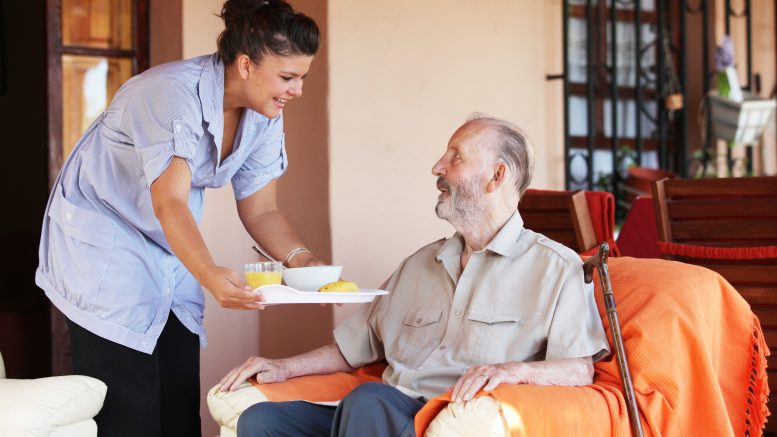To live at home with family instead of in a skilled nursing facility, many senior adults and people with disabilities, dementia and other debilitating conditions turn to in-home care providers for help.
“Most folks who have established homes would prefer to stay there as long as they can,” says Melissa Jacobs, Deputy Director for Senior and Adult Services at the Sacramento County Department of Child, Family and Adult Services. “They don’t necessarily want to be separated from their family and friends. They don’t want to go into a facility with strangers caring for them.”
Individuals desiring to help someone receive care in their own home can become a care provider through California’s In-Home Supportive Services program and make a real difference.
“In-Home Supportive Services is a Medi-Cal-funded program for individuals who can safely remain in their homes with home-based services or care to keep them out of more restrictive placements such as a skilled nursing facility,” says Jacobs. “We’re trying to keep folks in their own homes as long as we possibly can.”
Care providers perform a number of duties for clients, from basic household cleaning, vacuuming and mopping to meal preparation, grocery shopping and accompaniment to medical appointments.
In-home care duties may also include personal care such as bathing, repositioning bedbound recipients and administering medications.
Recipients can choose whoever they want as their in-home care provider, whether it is a relative, neighbor or friend, Jacobs says.
“What makes caregiving meaningful is that an individual gets to continue to live with dignity in their own home and be cared for by someone of their choosing,” Jacobs says. “And the individual providing the care gets to know that they’re making that happen for somebody else and that they’re doing something good for somebody else.”
Melissa Jacobs, Deputy Director for Senior and Adult Services, Sacramento County Department of Child, Family and Adult Services
“Approximately 70% of IHSS care providers are actually known family members of the recipient,” she says.
But in California, the State requires that prospective, paid, in-home care providers enroll as a care provider. In Sacramento County, that process occurs with the IHSS Public Authority.
Enrolling with the IHSS Public Authority helps ensure that prospective care providers are qualified to work in the IHSS program. The enrollment process includes an on-site orientation and background check through the Department of Justice, where certain criminal history may disqualify an individual from working in the IHSS program, but successfully appealed charges and lower-level crimes are allowed.
And while California does not require specialized training to become an in-home care provider, free caregiving classes are available through the California Department of Social Services (CDSS) with their new IHSS Career Pathways Program, as well as through the local IHSS Public Authority, for all IHSS enrolled caregivers.
Through Career Pathways, IHSS enrolled caregivers learn caregiving basics, home safety, fall prevention, food safety, CPR and first aid. This free program offers courses that give IHSS caregivers an understanding of conditions like Alzheimer’s disease, dementia, traumatic brain injuries, autism and developmental disabilities. Additionally, through a temporary program, CDSS is currently paying some stipends to IHSS care providers who complete certain Career Pathways training courses and meet the specified conditions.
Through the local IHSS Public Authority, free caregiver training is offered both on-site and online. Post-pandemic, an online library of 300+/- caregiver training videos, that are available 24 hours a day, was added as a first step toward expanding training access beyond a single physical location. Plans include expanding on-site classes, starting with more remote county locations. These free trainings include all the previous subjects listed above; however, the local trainings do not have any incentive pay associated with class completion.
Completing the classes can help make a caregiver be more in demand, Jacobs says.
“The recipient gets to choose you,” she says. “So to have skills in caregiving for specific disorders or specific diseases, or expertise in a particular area, makes you a desirable candidate to be hired by a recipient.”
And Career Pathways offers stipends to caregivers as incentives to complete training, Jacobs says.
“IHSS is a recipient-driven program, which means recipients and their families get to choose and train the care provider the way they want to be cared for,” Jacobs says.
So who is best suited to become an in-home care provider? People with patient, nurturing personalities, Jacobs says.
Additionally, having a flexible schedule also helps.
“Being able to have some flexibility in your schedule to be available when the recipient actually needs the care, I think is really important,” she says.
Candidates may include a student who can work a few hours a day. They could also be a retiree or a retired nurse or physician’s assistant or others with medical training, or someone thinking about getting into the medical field.
Even stay-at-home parents who can work during the day when their children are in school would make good candidates, Jacobs says.
“What makes caregiving meaningful is that an individual gets to continue to live with dignity in their own home and be cared for by someone of their choosing,” Jacobs says. “And the individual providing the care gets to know that they’re making that happen for somebody else and that they’re doing something good for somebody else.”
For more details about IHSS and the Career Pathways Program, visit the California Department of Social Services website at www.cdss.ca.gov and click “In-Home Support Services.”


























